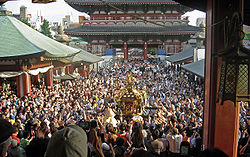Sanja Matsuri
| Sanja Matsuri | |
|---|---|

|
|
| Observed by | Tokyo |
| Type | Religious |
| Significance | Honors Hinokuma Hamanari, Hinokuma Takenari and Hajino Nakatomo, the three founders of Sensō-ji |
| Begins | Friday |
| Ends | Sunday |
| Date | Third Sunday in May |
| 2016 date | May 15 |
| 2017 date | May 21 |
| 2018 date | May 20 |
| 2019 date | May 19 |
| Frequency | annual |
Sanja Matsuri (三社祭?, literally "Three Shrine Festival"), or Sanja Festival, is one of the three great Shinto festivals in Tokyo. It is considered one of the wildest and largest. The festival is held in honor of Hinokuma Hamanari, Hinokuma Takenari and Hajino Nakatomo, the three men who established and founded Sensō-ji. Sanja Matsuri is held on the third weekend of every May at Asakusa Shrine. Its prominent parades revolve around three mikoshi (portable shrines referenced in the festival's name), as well as traditional music and dancing. Over the course of three days, the festival attracts 1.5 to 2 million locals and tourists every year.
Like many Japanese festivals, Sanja Matsuri is a religious celebration. It is a weekend-long Shinto festival that is dedicated to the kami (spirits) of three men. It is believed that two fishermen—brothers named Hinokuma Hamanari and Hinokuma Takenari—found a statuette of the Bodhisattva Kannon caught in a fishing net in the Sumida River on the early morning of March 18, 628. The third man, a wealthy landlord named Hajino Nakatomo, heard about the discovery, approached the brothers and converted them to Buddhism. The three men then devoted their lives to the Buddhist faith and consecrated the statue in a small temple. This temple, now known as the Sensō-ji, currently houses the Kannon statue and is the oldest temple in Tokyo.
The Sanja Matsuri appears to have many forms that date back as early as the 7th century, as well as several names such as "Kannon Matsuri" and "Asakusa Matsuri". Sanja Matsuri's present day form was established during the Edo Period. In 1649, shogunate Tokugawa Iemitsu commissioned the construction of Asakusa Shrine, a Shinto shrine dedicated to the three kami. The existence of this shrine helped to solidify the festival's importance as well as its current structure and organization.
...
Wikipedia
